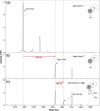Biosynthesis of Antituberculosis Antibiotic Capreomycin Involves a trans-Iterative Adenylation Domain within the Nonribosomal Peptide Synthetase Machinery
- PMID: 40815678
- PMCID: PMC12400406
- DOI: 10.1021/acs.orglett.5c03112
Biosynthesis of Antituberculosis Antibiotic Capreomycin Involves a trans-Iterative Adenylation Domain within the Nonribosomal Peptide Synthetase Machinery
Abstract
Capreomycin (CMN) is a nonribosomal peptide (NRP) antituberculosis antibiotic. CMN biosynthesis involves a non-canonical trans-iterative adenylation (A) domain. Here, we report that the A domain-less nonribosomal peptide synthetase (NRPS) module CmnI utilizes another module's A domain CmnA-A1 to load the required amino acid onto its thiolation (T) domain. This study provides evidence of an unusual mode of NRP biosynthesis in bacteria, involving a trans-iterative A domain in the NRPS machinery.
Figures





References
-
- Bruniera F. R., Ferreira F. M., Saviolli L. R., Bacci M. R., Feder D., da Luz Goncalves Pedreira M., Sorgini Peterlini M. A., Azzalis L. A., Campos Junqueira V. B., Fonseca F. L.. The use of vancomycin with its therapeutic and adverse effects: a review. Eur. Rev. Med. Pharmacol. Sci. 2015;19:694–700. - PubMed
- Kahne D., Leimkuhler C., Lu W., Walsh C.. Glycopeptide and lipoglycopeptide antibiotics. Chem. Rev. 2005;105:425–448. doi: 10.1021/cr030103a. - DOI - PubMed
-
- Claussen C. A., Long E. C.. Nucleic Acid recognition by metal complexes of bleomycin. Chem. Rev. 1999;99:2797–2816. doi: 10.1021/cr980449z. - DOI - PubMed
- Du L., Sanchez C., Chen M., Edwards D. J., Shen B.. The biosynthetic gene cluster for the antitumor drug bleomycin from Streptomyces verticillus ATCC15003 supporting functional interactions between nonribosomal peptide synthetases and a polyketide synthase. Chem. Biol. 2000;7:623–642. doi: 10.1016/S1074-5521(00)00011-9. - DOI - PubMed
-
- Stiller C. R., Dupre J., Gent M., Jenner M. R., Keown P. A., Laupacis A., Martell R., Rodger N. W., Vongraffenried B., Wolfe B. M. J.. Effects of cyclosporine immunosuppression in insulin-dependent diabetes-mellitus of recent onset. Science. 1984;223:1362–1367. doi: 10.1126/science.6367043. - DOI - PubMed
- Loor F., Tiberghien F., Wenandy T., Didier A., Traber R.. Cyclosporins: Structure-activity relationships for the inhibition of the human formylpeptide receptor. J. Med. Chem. 2002;45:4613–4628. doi: 10.1021/jm010987v. - DOI - PubMed
-
- Fischbach M. A., Walsh C. T.. Assembly-line enzymology for polyketide and nonribosomal peptide antibiotics: Logic, machinery, and mechanisms. Chem. Rev. 2006;106:3468–3496. doi: 10.1021/cr0503097. - DOI - PubMed
- Sussmuth R. D., Mainz A.. Nonribosomal Peptide Synthesis-Principles and Prospects. Angew. Chem., Int. Ed. Engl. 2017;56:3770–3821. doi: 10.1002/anie.201609079. - DOI - PubMed
MeSH terms
Substances
LinkOut - more resources
Full Text Sources
Miscellaneous

